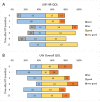A Prospective Phase II Study of Automated Non-Coplanar VMAT for Recurrent Head and Neck Cancer: Initial Report of Feasibility, Safety, and Patient-Reported Outcomes
- PMID: 35205686
- PMCID: PMC8870161
- DOI: 10.3390/cancers14040939
A Prospective Phase II Study of Automated Non-Coplanar VMAT for Recurrent Head and Neck Cancer: Initial Report of Feasibility, Safety, and Patient-Reported Outcomes
Abstract
This study reports the initial results for the first 15 patients on a prospective phase II clinical trial exploring the safety, feasibility, and efficacy of the HyperArc technique for recurrent head and neck cancer treatment. Eligible patients were simulated and planned with both conventional VMAT and HyperArc techniques and the plan with superior dosimetry was selected for treatment. Dosimetry, delivery feasibility and safety, treatment-related toxicity, and patient-reported quality of life (QOL) were all evaluated. HyperArc was chosen over conventional VMAT for all 15 patients and enabled statistically significant increases in dose conformity (R50% reduced by 1.2 ± 2.1, p < 0.05) and mean PTV and GTV doses (by 15.7 ± 4.9 Gy, p < 0.01 and 17.1 ± 6.0 Gy, p < 0.01, respectively). The average HyperArc delivery was 2.8 min longer than conventional VMAT (p < 0.01), and the mean intrafraction motion was ≤ 0.5 ± 0.4 mm and ≤0.3 ± 0.1°. With a median follow-up of 12 months, treatment-related toxicity was minimal (only one grade 3 acute toxicity above baseline) and patient-reported QOL metrics were favorable. HyperArc enabled superior dosimetry and significant target dose escalation compared to conventional VMAT planning, and treatment delivery was feasible, safe, and well-tolerated by patients.
Keywords: HyperArc; SBRT; non-coplanar VMAT; recurrent head and neck cancer; reirradiation.
Conflict of interest statement
A.U.K., J.V.H., M.L.S., R.K.C. and M.C. report personal fees and grants from Varian Medical Systems, ViewRay, VisionRT, and/or ASTRO outside the submitted work.
Figures





References
-
- Brockstein B., Haraf D.J., Rademaker A.W., Kies M.S., Stenson K.M., Rosen F., Mittal B.B., Pelzer H., Fung B.B., Witt M.E., et al. Patterns of failure, prognostic factors and survival in locoregionally advanced head and neck cancer treated with concomitant chemoradiotherapy: A 9-year, 337-patient, multi-institutional experience. Ann. Oncol. 2004;15:1179–1186. doi: 10.1093/annonc/mdh308. - DOI - PubMed
-
- National Comprehensive Cancer Network Clinical Practice Guidelines in Oncology: Head and Neck Cancers (Version 3.2021) [(accessed on 11 February 2022)]. Available online: https://www.nccn.org/professionals/physician_gls/pdf/head-and-neck.pdf.
-
- Janot F., de Raucourt D., Benhamou E., Ferron C., Dolivet G., Bensadoun R.J., Hamoir M., Géry B., Julieron M., Castaing M., et al. Randomized trial of postoperative reirradiation combined with chemotherapy after salvage surgery compared with salvage surgery alone in head and neck carcinoma. J. Clin. Oncol. 2008;26:5518–5523. doi: 10.1200/JCO.2007.15.0102. - DOI - PubMed

